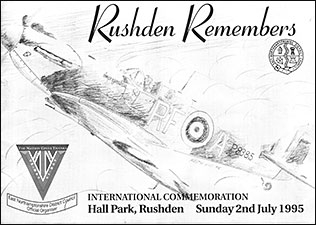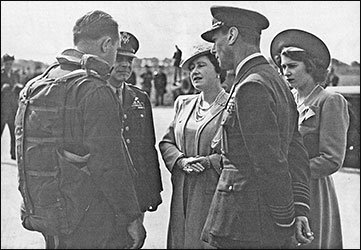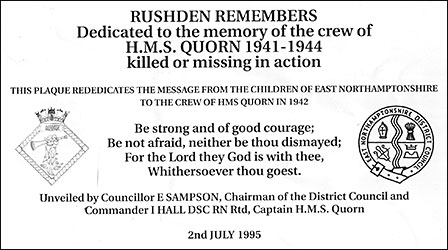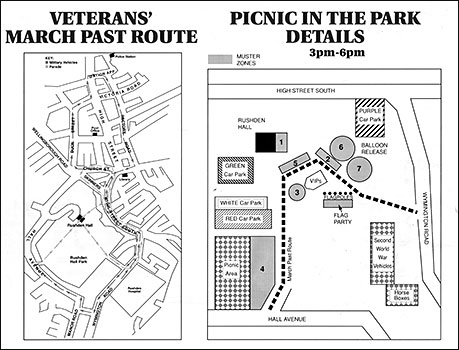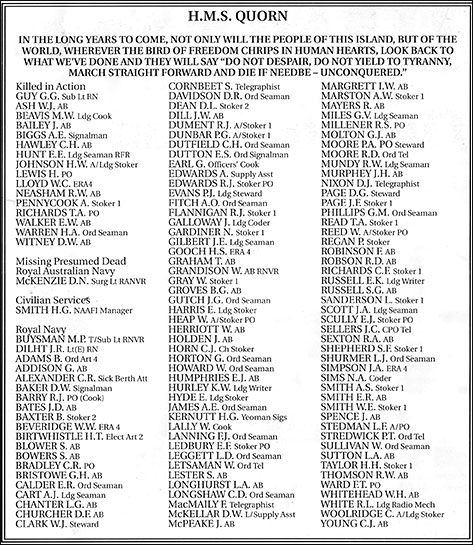|
||||||||||||||||||||||||
| From the Programme booklet |
||||||||||||||||||||||||
|
1995 Rushden Remembers VE Day
|
||||||||||||||||||||||||
|
||||||||||||||||||||||||
Mighty 8th Air Force Returns to Northamptonshire for Rushden Remembers In February 1944 and within just three months of the
At its peak it could assemble over 3,000 aircraft of various types in the air, with over 200,000 air and ground crew controlled by it. By 1945 some 350,000 Americans had served in the 8th Air Force including all of the RAF's volunteer Eagle Squadrons which had been in action since 1940, and which were transferred to the 8th Air Force in 1943, giving the Mighty Eighth a fighting pedigree right back to the Battle of Britain, and the very commencement of the war with Germany. In all, seventeen Congressional Medals of Honor were awarded to airmen of the 8th Air Force, all to bomber crewmen, and many were posthumously awarded, and whilst accounts vary, some 26,000 airmen gave their lives during the war. Locally no less than 5 Medals of Honor were awarded to airmen stationed at Chelveston and Podington. Joining Rushden Remembers today are the veterans of Fame's Favored Few, the 92nd Bombardment Group who served at Podington on the outskirts of Rushden. The 92nd Bombardment Group was the oldest formation in the 8th Air Force, and the first to cross the Atlantic to the United Kingdom non-stop in August 1942. Originally stationed just to the north-west of London it became the VIII Bomber Command Combat Crew Replacement Unit and in its early months flew four missions over Germany despite being primarily an operational training unit not yet fully ready for combat duty. By New Year 1943 however, most of the groups had been relocated to Alconbury to reform as a fully operational Bombardment Group before transfer to Podington on the outskirts of Rushden. On 14th May 1943, the 92nd Bombardment Group achieved operational status thereafter playing a vital part in the 8th Air Force's raids on strategic objectives in Germany and occupied Europe over the next two years to the end of the European theatre of operations on the surrender of Germany. Additionally, the 92nd Bombardment Group flew experimental missions using the Disney Rocket Bomb especially developed to destroy German U-Boat Submarine Pens along the Channel Coast. Disney Bombs were rocket propelled but dropped conventionally. When some 5,000 feet above their target, the rocket motors started and raised the bombs speed to such an extent that it could travel through twenty feet of reinforced concrete before exploding. Over its period of operations from the United Kingdom the 92nd Bombardment Group lost some 154 aircraft in action. Let us not forget either the role of other local 8th Airforce groups which have forever left an impression on the people of East Northamptonshire. To those who served with the 305th Bombardment Group at Chelveston, Rushden Remembers that it too lost 154 aircraft through enemy actions. At Polebrook, first the 97th and later the 351st Bombardment Groups took the daylight bombing war to the midst of Germany. Heavy bombers needed their fighter escorts and locally this was provided by, amongst others, the 56th Fighter Group based at Kings Cliffe, who lost 87 aircraft whilst on bomber escort duty. |
||||||||||||||||||||||||
|
||||||||||||||||||||||||
|
HMS Quorn - The Northamptonshire Navy As the German Navy increasingly turned to a submarine war to bring Great Britain to its knees, the Royal Navy responded by the development of ever more sophisticated antisubmarine warfare techniques to support the invaluable work of RAF Coastal Command which by 1941 had assumed the prime antisubmarine role. Ever increasing numbers of antisubmarine destroyers were needed to escort convoys and to keep the seas around Britain as free as possible of German U-Boat activity. By early 1941 a new class of Hunt Destroyer had been designed using the class name (Hunt) which had hitherto been reserved for mine sweepers. During Warship Week 1941, Rushden, along with countless other towns in the country, raised enormous sums of money for war purposes and in just seven days the colossal sum of £250,092 was raised by public subscription ranging from local school children collecting ship half pennies to large anonymous donations from wealthier residents. The result of this tremendous effort was that the building cost of HMS Quorn, a Hunt Class Destroyer, was raised, and an association was formed which was to bond the ship and town until HMS Quorn was lost in the English Channel in 1944 through enemy actions. To mark this association Rushden was given a large ship's plaque by the ship's captain whilst through the endeavours of local school children from Rushden, Raunds and Higham Ferrers enough money was collected to buy every member of the ship's crew a Bible, A few of these original bibles still exist today, treasured by former crew members as a priceless keepsake. Until her sinking in 1944, HMS Quorn cemented herself in the hearts of the local populace and she became, with others of her type adopted in the county, the "Northamptonshire Navy" taking the war to the enemy in a positive way attacking U-Boats and keeping much larger German Naval Units in the harbours of occupied France, Holland and Belgium. This naval report from 14th October 1942 illustrates just how well she did her job: "Last night a RAF Coastal Command aircraft from Calshot spotted the German cruiser 45 KOMET attempting to break out from Le Havre, westward to the Atlantic, and escorted by the 3rd Schnellboot Flotilla and by German minesweepers. In an attack by a Royal Navy Flotilla of Hunt Destroyers including HMS Quorn, Cottesmore, Endale and Glasdale plus HMS Albrighton, Komet was sunk. HMS Brocklesbury survived the action but with a large number of casualties on board whilst German Schnellboot S81 sank HMS Jasper separately making for Portland." HMS Quorn was to take part in the Normandy invasion in 1944, but shortly afterwards, whilst on anti-submarine and Schnellboot (E-Boat) patrol, was sunk with much consequent loss of life. Her battle honours included the North Sea, English Channel and the Normandy invasion.
|
||||||||||||||||||||||||
